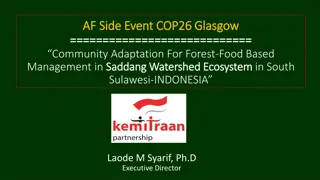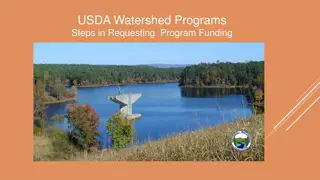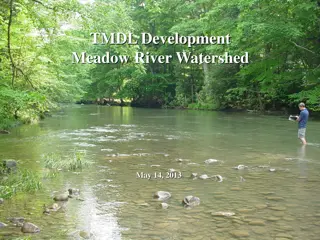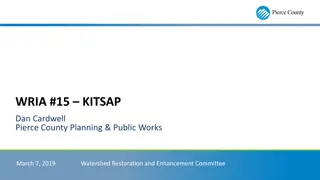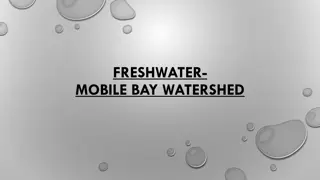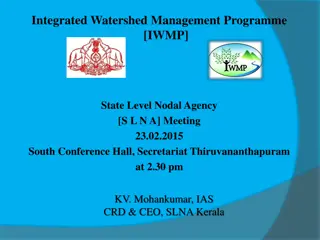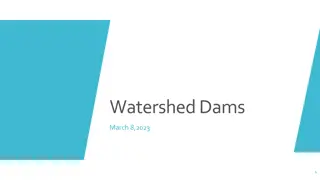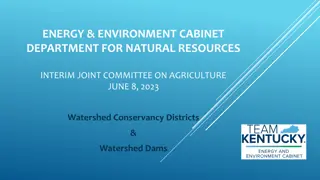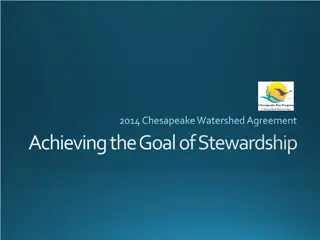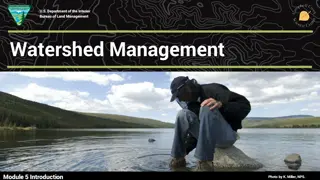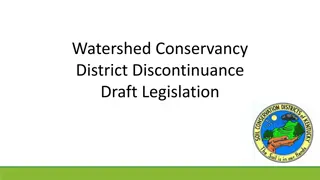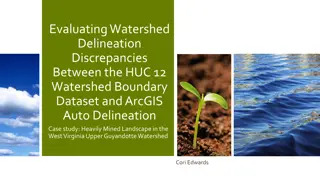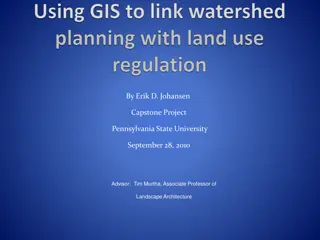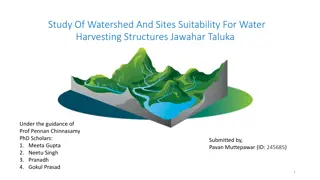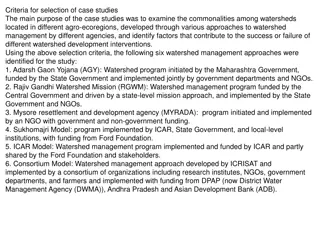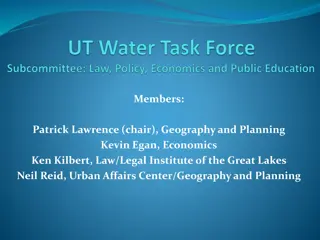Community-Based Management in Watershed Development
Techniques to initiate community participation in watershed management are crucial for sustainable development. Scholars classify participation levels into different categories, highlighting the importance of ideological motivation and voluntary engagement. The shift from direct intervention to participatory methods in rural development signifies empowerment of local participants. The benefits of community involvement in watershed development include cost-effectiveness, transparency, and sustainability.
Download Presentation

Please find below an Image/Link to download the presentation.
The content on the website is provided AS IS for your information and personal use only. It may not be sold, licensed, or shared on other websites without obtaining consent from the author.If you encounter any issues during the download, it is possible that the publisher has removed the file from their server.
You are allowed to download the files provided on this website for personal or commercial use, subject to the condition that they are used lawfully. All files are the property of their respective owners.
The content on the website is provided AS IS for your information and personal use only. It may not be sold, licensed, or shared on other websites without obtaining consent from the author.
E N D
Presentation Transcript
CHAPTER 3 COMMUNITY BASED MANAGEMENT AND CO-MANAGEMENT IN WATERSHED DEVELOPMENT 3.1 Techniques to initiate community participation 3.2 Participatory VS Collaborative Watershed Management
Definitions The following terms are in/directly important: Participation means opening up the design of the system to include those most directly affected and agreeing to analyze data together. is an important dimension between program managers, Negotiation implementers and community members to agree on what will be done, how and when the data will be collected and analyzed, what the data actually means, how the findings will be shared and what actions will be taken. Flexibility is essential as the number, role and skills of stakeholders and other factors change over time.
Scholars also classify level of participation in to the following categories. Ideological motivation- mass participation of the rural people and of organized community groups on the base of religious, political or ethical awareness and motivation campaign or as part of ideological education. Compulsory participation- by means of regulatory measures, supervised credit, tied land lease and other entitlement (grazing right, water right ) participation without much conviction and willingness or continue to suffer hardship Voluntary participation- by appealing to the individuals or collective interest of the local people in such a way that there is effective response to action.
Others classify it: Passive participation Participation in giving information Participation by consultation Participation for material incentives Functional participation Interactive participation Self-mobilization
Techniques to initiate community participation Rural development over the past 20 years has been marked by a gradual shift from the intervention-based method to an approach promoting rural people s involvement in their own development Direct Intervention Method Vs Participatory Method. Direct intervention method Participatory method oTechnology-based approach oMulti-faceted oPreparation of directives oAll players oTransmission of directives oListening to local people oSubsidy allocation oAppropriate solution oConduct of managerial staff oEmpowerment of local participants
In response to the technical, social and economic failures of many past efforts in soil and water conservation, recent years have seen the growth of more participatory approaches to watershed development. Percolation of benefits to the grassroots level, cost effectiveness, transparency, sustainability, equity and harmonization with the indigenous traditional knowledge are among several benefits now being considered to be realized with the bottom-up approach of people s participation.
Ensuring Public participation: Sustainability, Equity and Participation are the three basic elements of participatory watershed management. Sustainability involves conservation and enhancement of the primary productivity of the ecosystem, the main components of which are land, water and biomass. Equity has to be seen in terms of creating an equitable access to livelihood resources for the watershed community. Participatory watershed management attempts at ensuring sustainability of the ecological, economic & social exchanges taking place in the watershed territory In addition to natural resource exchange participatory watershed management considers the economic, political and cultural exchanges
Community Participation In real terms community participation means voluntary sharing by users group their time, energy & money on program & adopt the recommended measures and practices on a sustained basis. People s participation is critical for the success of the watershed program because the sum of individual choices has collective consequences on management of natural resources. In community participation people act collectively & influence outcomes.
For success of community participation, 3 aspects are critical: 1. the ability of members to participate as a community or to have a collective voice; 2. decision made jointly by the community and implementing organizations; and 3. communities bearing a share of costs. Conditions for facilitating people s participation: 1. Making people aware about potential benefits of collective action in conserving & managing natural resources Collective action can be defined as the pursuit of a goal or set of goals by more than one actor. 2. Demand-driven activities in the watershed program; 3. Empowering people in planning, implementing & managing watershed programs; 4. Sufficient private economic benefits to create incentives for participation.
Empowering the community When people are empowered to take decisions & execute the activities, they own the program. They run the watershed activities according to local, social & cultural systems. Hence, community participation takes into account three basic facts: Natural resources management can not be successful and sustainable with out the support and participation of natural resource users. Participants should have decision-making capacity and responsibility (empowerment). The promotion of participation in watershed management is a long process that requires time and appropriate techniques
Other possible strategies to promote and ensure land users participation: At the beginning of the project, small demonstration plot should be established in sufficient numbers on private as well as public lands. An intensive education and extension campaign should follow using the result of the demonstration plots If needed, a financial incentive program (subsides and credit) ??? A technical assistance program should also be available to whoever wants to join the watershed projects A special effort should be made to organize interested farmers A regular follow up and inspection system should be established to help the farmers in maintenance, cropping and marketing activities
Is providing incentive for people who participate in watershed help for sustaining it? Two school of thought - Supporting or against incentives for land users in implementing watershed management activities Entry points for discussion and literature review Poor farmers, in order to become part of the development process, need a big push if the inertia of under-development and misuse of the resources are to be halted. Conservation measures have beneficial effects in society as a whole and on the stability and wise use of the nation s resources; therefore the cost of implementing conservation and restoration work should not be absorbed exclusively by the small farmers. Cost for implementing some watershed management activities are not affordable for small farmers whereas watershed degradation/ management effect and impact is beyond farm level.
Participatory VS Collaborative Watershed Management Emerging paradigms and new thinking Watershed management approach evolved through different stages of development (Paradigm shift): Classic Forestry and forest related hydrology (focus on forest protection, concern of government forest departments: see Fiebiger, 1993) 1. Land resource management for economic benefits (focus on SWC and beneficiaries e.g., FFW, community forestrty, hillside planting top-down) 2. Participatory and integrated (involving local people, incoporating their contribution, focus on livelihood and resource management-bottom up or top down) 3. New Collaborative management (pluralist, based on mutual learning, exchange and negotiation among stakeholders with diverse interests and concern) 4.
The classic Vs the new approaches The classic approaches Integration of socioeconomic/ livelihood issues within watershed management programs Focus on community participation with emphasis on bottom-up planning The new approaches (Recent) More emphasis on watershed resource management as part of socioeconomic development process Focus on multi-stakeholder participation linking social, technical and policy concerns in a pluralist collaborative process Flexible program design, adjustable to local conditions and long-term planning Implementation is left to watershed management fora, consortiums and associations, with authorities playing a facilitating role Focus on up-stream down-stream linkages and long- term impacts. Local level processes coordinated at the watershed or basin level Dialogue between local and scientific knowledge involving different stakeholders Access, tenure and social conflicts in watersheds are rooted in society and politics and should be managed through negotiations Rigid program design, weak institutional arrangement at local level, short-term planning Implementation is left to institutions such as donor assisted programs or government authorities Focus on on-site, short-term effects. small scale projects with littlewatershed level coordination Quick participatory assessment and evaluation (PRA) with little or no linkages to natural evidences Access, tenure and social conflicts in watersheds can be solved by technical interventions
In the new approach, communities are not the only important actors in participatory watershed management. Collaboration between the various actors such as associations, cooperatives, local administration, line departments, NGOs and private sector is needed for successful participatory watershed management. As the different actors have diverse and sometimes conflicting interests, the goal of participatory watershed management has moved from social mobilization to negotiation and partnership (collaboration). Collaborative watershed management process must be based on shared knowledge than relying on only hard sciences and social surveys
Participatory o Focuses on communities and people and targets grassroots social actors: households, small communities Collaborative o Focuses on civil society and targets a variety of social and institutional actors, including local governments, line agencies, organizations, experts and policy makers o Based on the assumption that sound natural resource management is a public concern shared by all social actors o Based on the recognition that stakeholders have particular, conflicting interests in natural resources and need to be accommodated o Seeks to make decisions through a bottom-up process, by which grass roots aspirations are progressively refined and turned into operational statements and action o Centered on the watershed management program, with local government assisting as a side supporter o Seeksto merge stakeholders aspirations and interests with technical experts recommendations and policy guidelines through a continued two-way (bottom-up and top-down) negotiation process in making a decision o Centered on the local governance process, with the watershed management program acting as facilitator and supporter o Aimed at creating a general consensus, presuming that conflict can be solved through dialogue and participation o Aimed at managing social conflicts over natural resources, based on awareness that dialogue and participation can mitigate conflicts, but not solve them structurally
Participatory community based watershed management (CBWM) CBWM is an approach that enables individuals, groups, and institutions with a stake in management outcomes to participate in identifying and addressing local issues that affect watershed functions. Involving local stakeholders in CBWM results in more locally relevant solutions that take into account each community's unique social, economic, and environmental conditions and values. Stakeholder participation also creates a sense of local ownership of identified problems and solutions, thus ensuring long-term support for resulting management plans.
Characteristics of CBWM Changing Roles & Relationships: As local communities participate more actively in watershed management, roles & relationships of resource managers & stakeholders will change. CBWM recognizes that all stakeholders have a critical role to play in the management planning process, but must work collaboratively to understand and address watershed issues Whole-System Perspective: Watershed management is not a single strategy, but is a general approach to water resource protection that recognizes the interconnectedness of all the physical and biological components of the landscape, including human communities.
A community-based approach considers not only the physical characteristics of a watershed, but it also takes into account the social and economic factors associated with watershed issues. The goal of community-based watershed management is to protect and restore watershed functions while considering the variety of social and economic benefits of those functions
Integration of Scientific Information & Societal Values: Watershed management decisions should be based on sound scientific information, both in terms of identifying problems and selecting options for addressing those problems. However, they must incorporate a broad range of social values in the management process by involving representatives from a diverse cross-section of the community throughout the management planning process.
Adaptive Management Style: Addressing environmental, social, and economic issues at the watershed scale is complex, and often there is a high level of uncertainty regarding the outcomes of management decisions. Effective CBWM entails an experimental approach to management in the sense that participants must be prepared to learn from their mistakes and to adapt their management strategies to changing conditions.
Key factors for success in CBWM Involve stakeholders in the management planning process in a meaningful way to them and that allows them to use their particular skills and knowledge most effectively. Begin by educating and informing key figures about the values of the watershed to the community, the watershed management process, and specific actions they can take to get involved. View the watershed management plan as a starting point and not the end product. Be prepared to adapt the plan as conditions change and groups learn from their mistakes.
Make management decisions based on a consensus of a broad range of stakeholders. Focus on desired outcomes (e.g., clean water), which can often be more helpful and motivating for participants
Community-based watershed management challenges Some key stakeholders may lack the motivation, skills, or resources to participate effectively throughout the management planning process. Conflicts between stakeholders over management goals and the means to accomplishing those goals (dialogue and negotiation) and resource management professionals are often ill-prepared to facilitate constructive dialogue to resolve these conflicts. Community-based approaches require time and resources to generate interest and to build relationships between stakeholders. Funding agencies and stakeholders may grow impatient with the lack of observable outcomes
The process of community and stakeholder participation How do we make participation work in CBWM? Forming Watershed Teams at different levels. Woreda level Watershed Team (WWT) Composition: Group of multidisciplinary experts from sector offices (technical team) Main task: Technical coordination at woreda level. Identification of major watersheds and critical units in the woreda Selection and prioritization of community watersheds in the woreda
Kebele level Watershed Team (KWT) Composition: Kebele officials, development agents, opinion leaders, youth representative, women representative Main task: Coordination of community watersheds within the critical watershed units Community level Watershed Team (CWT) Composition: Gender balanced (women and men), faith balanced (religion), status balanced (poor and rich), you representative Main task: Deals with watershed planning within the community boundaries and outside the community boundary based on interactions with other communities
Reading assignment Read and take detail notes from: German et al, 2007. Participatory integrated watershed management: Evolution of concepts and methods in an ecoregional program of the eastern African highlands



